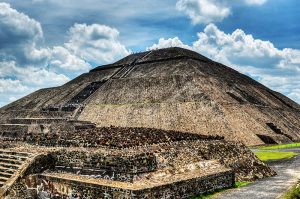Hidden Weakness

It towered for centuries over Teotihuacán, the largest city in pre-Columbian Mesoamerica. Today, Mexico’s famed Pyramid of the Sun risks slowly sinking and crumbling like a sand castle.
So warns nuclear physicist Arturo Menchaca, who led a National Autonomous University of Mexico study in 2014 that revealed a giant pile of dry dirt on the structure’s southern side, equivalent to roughly 10 percent of its total volume. That’s significant given that the exterior’s 3 million tons of volcanic rock rest on a mound of earth. Menchaca, who discovered the unstable spot while using a sub-atomic particle detector to search for internal chambers, attributed the soil’s 20 percent lower density to sun exposure. (The pyramid, built around A.D. 100, was excavated in 1910.)
Wetting the dry side, one proposed solution, could only exacerbate a problem with excess moisture, however. Cement additions, to shore up the pyramid’s rock-and-earth exterior decades ago, hindered vegetation growth, but they also prevented dampness from escaping, causing cracks. UNESCO cited such restoration efforts – along with land-use pressures – as a threat to this World Heritage site. While researchers consider ways to prevent the pyramid’s damage or collapse, the cement is being replaced with river sand and other more sustainable materials.
Update: In May 2021, alarm over potential damage to the Teotihuacán historic site again was raised – this time from unauthorized construction, the BBC reported.
This article originally appeared in the May/June 2014 issue of ASEE’s Prism magazine and was written by Deputy Editor Mary Lord.
Filed under: Special Features
Tags: construction, pyramid, sand, Structural Engineering, Tiotihuacan, UNESCO World Heritage Site








